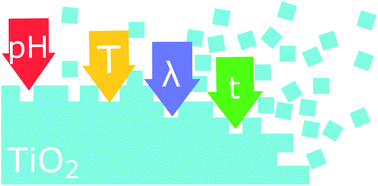Chemical and photoelectrochemical instability of amorphous TiO2 layers quantified by spectroscopic ellipsometry†
Abstract
Amorphous TiO2 films deposited by Atomic Layer Deposition (ALD) are recently being employed as corrosion protection coatings for photoanodes and photocathodes. However, these protective films are not immune to degradation. We have applied spectroscopic ellipsometry to quantify the loss of material, and the corresponding etch rates, for amorphous TiO2 in photoelectrochemical cells under a wide range of conditions, at open- and short-circuit, in darkness and under illumination with different wavelength ranges. In 0.5 M sulfuric acid, we found corrosion to proceed via two routes: a chemical process, with an activation energy of 57 kJ mol−1, and photoelectrochemically, once excess generated charge carriers are extracted. Compared to the dark condition, the combined degradation rate is more than doubled under illumination at 100 mW cm−2 and at pH 0.3–2. The observed etch processes are highly dependent on the acidic pH values and largely suppressed at pH > 4. This has important implications for the selection of operating conditions for practical photoelectrochemical cells using amorphous TiO2 protective coatings.



 Please wait while we load your content...
Please wait while we load your content...